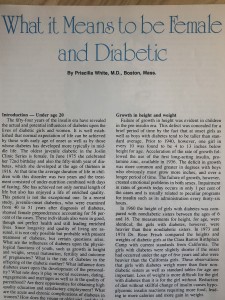 In 1975, Priscilla White received the ADA’s award for Outstanding Service to Diabetic (sic) Youth. Maybe they didn’t have an award for service to mothers with diabetes. Dr. White started at the Joslin Diabetes Center in 1925 – only four years after insulin was isolated in Canada – and she worked tirelessly to improve infant survival rates for mothers with diabetes. Here’s a snapshot of her work:
In 1975, Priscilla White received the ADA’s award for Outstanding Service to Diabetic (sic) Youth. Maybe they didn’t have an award for service to mothers with diabetes. Dr. White started at the Joslin Diabetes Center in 1925 – only four years after insulin was isolated in Canada – and she worked tirelessly to improve infant survival rates for mothers with diabetes. Here’s a snapshot of her work:
Years # Women followed Infant survival rate
1924-1938 128 54 %
1938-1958 900 86%
1958-1975 1170 90%
I was diagnosed with type 1 diabetes in 1975, and while Dr. White was involved with the diabetes camp I attended (and later worked at) in Massachusetts, I don’t remember meeting her. I do remember that one of the buildings had her name on it. Maybe she donated the money for it. It was an “infirmary” – where we took insulin and received nursing care for whatever camp ailments may have occurred. I remember sitting on the porch of that building, waiting for my “shot” every morning, before heading to breakfast. They brought the “shot” out on a little tray. We were encouraged to learn how to inject ourselves (that was, afterall, why my parents sent me to camp), and if we weren’t able to do that for whatever reason (like being 8 years old), they did it for us in that building.
Years later, that infirmary was converted to living space for CITs (counselors-in-training). We named it The White House, after Priscilla White (and to be ironic). And when the building was replaced with a new one, the name persisted.
We’ve come a long way from the days of telling girls and young women with newly diagnosed type 1 diabetes that they can’t or shouldn’t get pregnant. The focus has changed from infants not surviving a diabetes pregnancy to pre-pregnancy education. The goal is for women to have glucose levels in a safe range long before they ever get pregnant, so complications are minimized. To me that is incredible progress. In fact, we’ve moved to a more proactive approach in diabetes care, education, and management in many ways, and that is a good thing.
I imagine Priscilla White would be amazed if she could see the changes that have happened in diabetes care since 1975: the A1C measure and now increasing focus on time-in-range and improving coverage and use of continuous glucose monitoring (game-changer in pregnancy!); new types of insulin that work longer or faster; insulin pumps that are incredibly more sophisticated; and the list goes on.
I hope she would also be happy with the slow-yet-steady changes in our mindset, approaches, and messages about diabetes. Maybe she would name that article “What it Means to be a Female with Diabetes.”
